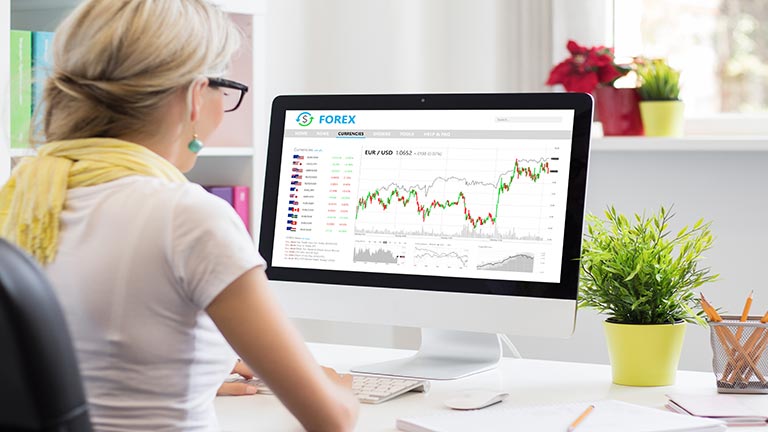ABC of Share Trading

By Dale Gillham
You don’t need an economics degree to buy into the share market. From the basics of the stock exchange to the golden rules of trading, Dale shares his knowledge on the ABC of share trading.
There are numerous ways to create wealth, and share trading can be one of the simplest and most cost-effective ways to get started. In fact, just about anyone can invest in the share market to build wealth, as long as they have a basic understanding of how it works and how to buy and sell shares.
The following is a good introduction to the ABC of share trading and continued self-education, and research will help you get the most from your investments long term.
The ABC of share trading
Put simply, a share is part ownership of a business. A company can raise money to finance its business by "going public", which means being listed on a stock exchange and issuing shares to investors through an initial public offering. By paying for the shares, investors buy part ownership of the company’s business and become a shareholder in the company.

You may remember the movie Trading Places with Eddie Murphy and Dan Aykroyd. At one point Billy Ray Valentine and Louis Winthorpe III are in "the pit" at the New York Stock Exchange, madly buying and selling shares on the floor as if their lives depended on it.
This is how all stock exchanges operated in Australia until the introduction of the Stock Exchange Automated Trading System (SEATS) in 1987. This computerised system superseded the outdated open outcry system that limited the extent to which stocks could be traded efficiently.
Like all markets, the Australian stock market is driven by supply and demand, whereby buyers and sellers are brought together to trade shares at current market prices. Prices are based on what price buyers are willing to pay (the bid) and what price sellers are prepared to sell at (the offer). In simple terms, orders are placed with SEATS and filled once a match between buyers and sellers is established.
Golden rules of share trading
In my experience most people spend more time deciding what to eat at a restaurant than they spend selecting which shares to buy, so for this reason I always recommend investors consider the following golden rules:
Golden rule #1
Irrespective of the amount of money you have to invest, you should always take the same amount of time researching your options to ensure you are protecting your capital on each and every occasion.
Golden rule #2
You should always aim to have between 5 and 12 stocks in your portfolio, although my preference is closer to 5. The trick is not to have lots of stocks with small amounts invested in each. Instead, you only require a small number of the right stocks with larger amounts invested in each. This actually lessens your risk and increases your returns.
Golden rule #3
When you purchase stocks, never invest more than 20 per cent of your total capital in any one stock. If you invest in the share market you need to accept that some stocks will fall in value. However, this rule will help reduce your exposure to risk, while allowing you to achieve good returns simply because you are minimising the amount of capital you could lose at any one time.
Golden rule #4
You should only ever invest 10 percent of your available capital in trading short-term highly leveraged markets and allocate the remaining 90 percent to trading a medium-to-long-term portfolio. This is a very solid money management rule that allows you to take a low-risk approach with your money while still achieving good returns on your capital.
To gain a more in-depth understanding of these rules, read my four golden rules to investing in shares.
Choosing which stocks to trade
Identifying the right stocks to place in your portfolio can seem like a daunting task. With more than 1500 on the Australian Stock Exchange (ASX), ho do you know which stocks to choose?
All too often, people feel like the job is too big and that it will take up too much of their time, which explains why many investors are happy to hand over control of their investments to others. But this needn’t be the case.
The list of stocks you select for your portfolio, however, will depend on the time you have available, your resources and the goal of your portfolio. That said, I recommend that most investors don’t stray to far outside the top 150 stocks on the Australian market for the following reasons:
- The stocks are highly liquid. In other words, there is a lot of buying and selling taking place in these stocks every day.
- Stocks from the top 150 are generally profitable businesses with some of the best managers in Australia, providing stability in the growth of the company and the share price.
- They generally pay good dividend yields with good tax credits attached. A dividend yield is the dividend shown as a percentage of the last sale price of the shares.
- Reliable information about these stocks is much easier to obtain.
- The chances of any one of these companies going broke is very small.
- These stocks will produce good returns over a 10-year period.
Venturing outside the top 150 stocks will not only increase your risk level but the knowledge you require to successfully manage the risk will be greater.
Unfortunately, a common misconception for newcomers to the share market is that buying these types of stocks is too expensive and that buying cheap stocks is the best method for achieving higher returns. But this belief not only costs you money, it hinders your ability to generate profits because you are investing your faith in speculative stocks. In other words, you are speculating that a cheap stock will perform better that a solid ‘blue-chip’ stock.
In reality, you want to buy quality stocks, not quantity, because this is where you will, for the most part, get the greatest returns. In fact my research suggests that if all you did was buy and hold the top 10 shares in the Australian market for 10 years, your portfolio return would average a return of at least 12 percent per annum.
Getting started

One of the most common questions I get asked is how much do I need to start investing in the share market? You can begin investing with as little as a $1,000, although you will want to develop a savings strategy so that you can build up your share portfolio until you hold at least five stocks (shares in five different companies).
Because of transaction costs (the cost to use a broker to buy and sell shares on your behalf), I always recommend that the minimum amount you should allocate to a particular stock is $1,000. Once you hold shares in a minimum of five stocks, you can begin to increase the amount of shares you hold in each company.
If you sell a stock, reinvest the capital from the sale into another stock, as well as any savings you may have accumulated to increase the amount you are purchasing. Gradually your position (the amount you hold in any one stock) will increase over time, rather than the number of stocks you own, which will ensure you are able to manage your investment risk.
Once you have organised your finances and decided which shares you’re interested in buying, you will need to choose a stockbroker who will act as your agent to buy and sell shares listed on the stock market.
Choosing a stockbroker
Broadly speaking, there are two types of brokers—the full service advice broker and the discount broker. Full service brokers don’t usually charge for the advice they give, but you will pay higher brokerage fees when you buy and sell shares because of the time and costs involved in researching the market and examining your personal needs. They can cost anywhere around $100 per trade, while discount brokers simply act on the instructions you give them, and usually charge from around $35 per trade.
If you are new to the market, I recommend using an advice broker until you develop the knowledge and confidence to buy and sell shares. A good advice broker will also help answer any questions you have when starting out. If you already understand how to buy and sell shares, discount brokers are likely to be more suitable.
In my experience, if you decide to invest in the top socks in the Australian share market and take a low-risk methodical approach to investing over the long term, you will achieve your financial goals. Obviously the more knowledge you acquire, the more confident you will be, which will lower the risk you take when investing in the share market.
Others who read this article also enjoyed reading:
- Trading the Stock Market - Why Most Traders Fail
- The Laws of Wealth Creation
- What is a Well Diversified Portfolio
You may also want to consider purchasing my latest book Accelerate Your Wealth, It's Your Money, Your Choice.
And If you would like to learn how you can gain the confidence to profitability trade the share market on a consistent basis click here. You can also check out the success of our clients by viewing their reviews and testimonials.






